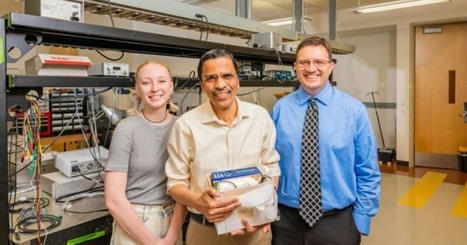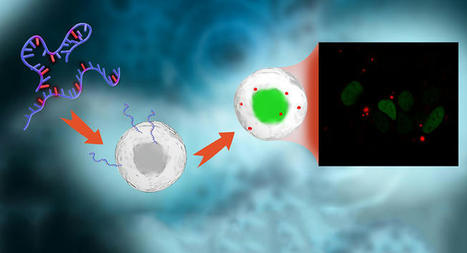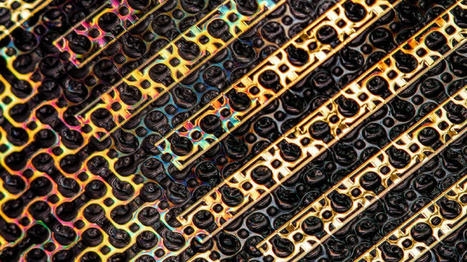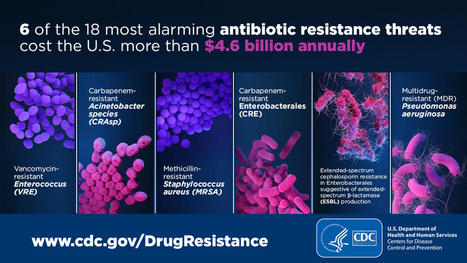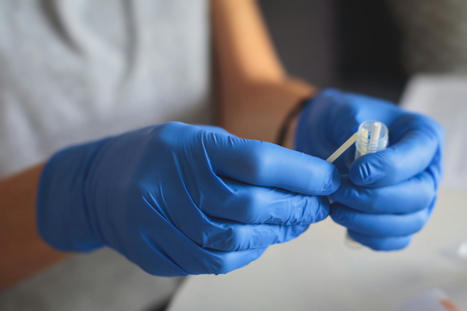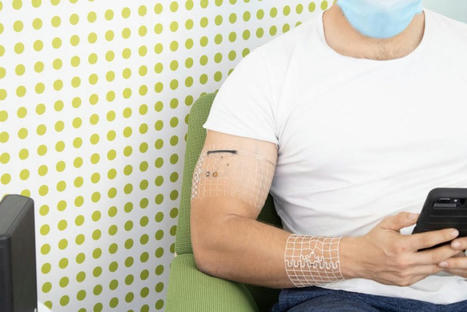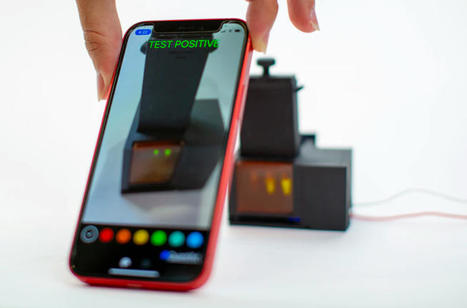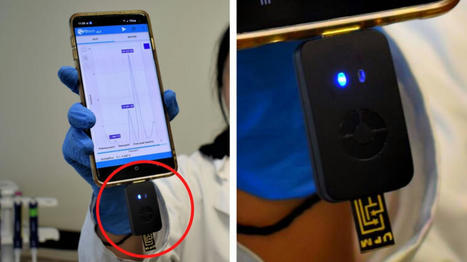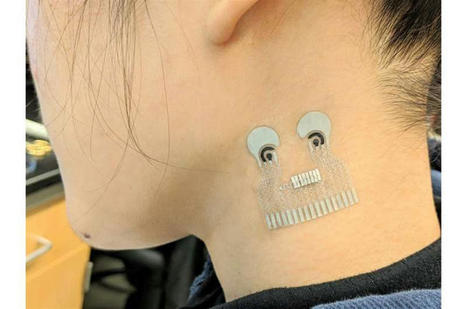 Your new post is loading...
 Your new post is loading...

|
Scooped by
Beeyond
December 21, 2021 1:51 PM
|
The new aptasensor has a wide range of sensitivity to different virus concentrations. It is thus capable of detecting concentrations below 0.5 nanomolars (nM), typical in patients who have not yet developed COVID symptoms, as well as working at higher concentrations (up to 32 nM), so it could provide clinical practices with an extra tool for monitoring the progress of infection in patients.

|
Scooped by
Beeyond
November 6, 2021 12:29 PM
|
Most currently available methods for monitoring hemoglobin require blood samples and expensive equipment. The available noninvasive spectroscopic methods have a high degree of variability and often are inaccurate in people of color due to differences in skin melanin. There is a significant unmet need for a reliable, noninvasive device to estimate hemoglobin, irrespective of skin color, he said.
The device relies on the spectroscopic properties of hemoglobin in the blue-green light spectra, as opposed to the red-infrared spectra currently used in similar devices. The device is easy to use, utilizing a probe that is placed on the skin and measures reflected light from the skin, Alexandrakis said.

|
Scooped by
Beeyond
October 17, 2021 6:47 AM
|
Digital health platform PreciseMDX introduced a cloud-based solution that automates and simplifies the diagnostic testing experience, empowering labs to deliver a transformative journey to providers and patients. PreciseMDX dramatically improves connectivity between clinical labs, providers, and patients during every step of the diagnostic testing process for any type of test.

|
Scooped by
Beeyond
September 13, 2021 3:18 AM
|
L'équipementier tricolore Valeo a présenté une borne capable de diagnostiquer le Covid sans contact et en moins de deux minutes. L'appareil est encore en phase de test. Pour fournir son diagnostic, la borne s'appuie sur deux dispositifs. Dans un premier temps, l'utilisateur doit répondre à une série de questions sur son état de santé. La machine cherche à savoir s'il tousse, s'il mouche ou encore, s'il a des douleurs thoraciques.

|
Scooped by
Beeyond
August 7, 2021 12:09 AM
|
Electrodermal devices that capture the physiological response of skin are crucial for monitoring vital signals, but they often require convoluted layered designs with either electronic or ionic active materials relying on complicated synthesis procedures, encapsulation, and packaging techniques. Here, we report that the ionic transport in living systems can provide a simple mode of iontronic sensing and bypass the need of artificial ionic materials.

|
Scooped by
Beeyond
July 9, 2021 12:15 AM
|
Researchers at Chalmers University of Technology in Sweden and collaborators created a technique to produce fluorescently labeled mRNA, allowing them to track its entry and distribution into cells. Using such molecules could help scientists develop better ways to deliver mRNA therapeutics into the body, potentially playing a vital role in the new wave of mRNA therapies, including vaccines.

|
Scooped by
Beeyond
July 4, 2021 12:33 PM
|
The new skin is equipped with artificial sweat ducts that resemble pores in human skin and that have been etched through the material’s ultrathin layers. This ensures that sweat can escape through the electronic skin avoiding damaging and deteriorating the wearable skin.

|
Scooped by
Beeyond
May 17, 2021 9:02 AM
|
It’s stretchable, like a band-aid, waterproof, and long lasting. In today’s Medical Moment, how this small patch may soon take the place of invasive health monitors. For many diabetics, daily monitoring of blood sugar means a finger prick. But what if there was a better way?

|
Scooped by
Beeyond
April 22, 2021 2:40 AM
|
CDC teamed up with experts at the University of Utah School of Medicine to estimate that treating six antibiotic resistance threats contribute to more than $4.6 billion in health care costs annually. Partnerships like this help CDC gain a better understanding of the impact of antibiotic resistance in healthcare, help clinicians target infection control practices, and support healthcare decision makers to make informed choices that improve patient safety. Cost estimates can help guide actions needed to prevent resistant infections.

|
Scooped by
Beeyond
April 12, 2021 11:04 AM
|
Similar to smartphone tech that detects low air quality, this microchip would pick up the coronavirus.

|
Scooped by
Beeyond
March 26, 2021 7:14 AM
|
Ninety percent of consumers would use an at-home COVID-19 test, including half who would use a test at least once per month. Of those surveyed, 75% would be willing to anonymously share their results with local public health officials, and 57% would be at least somewhat willing to share results with their names attached.

|
Scooped by
Beeyond
February 22, 2021 6:57 AM
|
Rapid diagnosis is critical for the treatment and prevention of diseases. An advanced nanomaterial‐based biosensing platform that detects COVID‐19 antibodies within seconds is reported. The biosensing platform is created by 3D nanoprinting of three‐dimensional electrodes, coating the electrodes by nanoflakes of reduced‐graphene‐oxide (rGO), and immobilizing specific viral antigens on the rGO nanoflakes. The electrode is then integrated with a microfluidic device and used in a standard electrochemical cell.

|
Scooped by
Beeyond
February 22, 2021 4:39 AM
|
The California Institute of Technology is working on an electronic skin, a sensor-filled sticker, that can turn human sweat into energy enough to power basic devices like heart-rate sensors, glucose-level trackers, or even a low-energy Bluetooth radio. These stickers work by harvesting ‘lactate’ from the sweat we produce. The lactate is absorbed by the electronic skin’s fuel cells – which are made from carbon nanotubes that host a platinum/cobalt catalyst and an enzyme that uses oxygen in the air to break down the lactate into water and a substance called pyruvate. CalTech’s researchers say these stickers can generate a continuous stream of energy (as much as “several milliwatts per square centimeter”), making it enough to offset the need for a battery, which the technology hopes to eventually replace.
|

|
Scooped by
Beeyond
December 20, 2021 4:32 AM
|
Compared to alternative platforms, this platform offers dosage-controlled intracellular delivery of large plasmids simultaneously to large populations of cells while maintaining cell viability at comparable delivery efficiencies.

|
Scooped by
Beeyond
October 25, 2021 4:38 AM
|
Grapheal développe des biocapteurs numériques embarqués, portables et jetables, permettant une surveillance et un diagnostic médical en continu. Cette nouvelle technologie apporte aux soignants un outil d'évaluation pour le développement d’une médecine de précision passant par la généralisation des diagnostiques rapides de terrain et le suivi à distance des patients.

|
Scooped by
Beeyond
October 15, 2021 4:27 AM
|
Wearable sensors to monitor everything from step count to heart rate are nearly ubiquitous. But for scenarios such as measuring the onset of frailty in older adults, promptly diagnosing deadly diseases, testing the efficacy of new drugs or tracking the performance of professional athletes, medical-grade devices are needed.

|
Scooped by
Beeyond
August 12, 2021 4:02 AM
|
This low-cost testing device is geared towards regions where access to sophisticated labs is not a given. “miSHERLOCK eliminates the need to transport patient samples to a centralized testing location and greatly simplifies the sample preparation steps, giving patients and doctors a faster, more accurate picture of individual and community health, which is critical during an evolving pandemic,” said Helena de Puig, a researcher involved in the study, via a Wyss Institute announcement.

|
Scooped by
Beeyond
July 9, 2021 12:16 AM
|
Researchers at Kumamoto University in Japan have designed an inexpensive and convenient filter that can isolate circulating tumor cells from as little as 1 mL of patient blood. The highly sensitive filter can successfully work in samples containing as few as five tumor cells in 1 mL of blood, and does not require expensive equipment or reagents, unlike certain pre-existing cell capture technologies. The filter may help in developing diagnostic technologies that can aid clinicians in identifying cancer early.

|
Scooped by
Beeyond
July 9, 2021 12:01 AM
|
Synthetic biology offers a way to engineer cells to perform novel functions, such as glowing with fluorescent light when they detect a certain chemical. Usually, this is done by altering cells so they express genes that can be triggered by a certain input. However, there is often a long lag time between an event such as detecting a molecule and the resulting output, because of the time required for cells to transcribe and translate the necessary genes. MIT synthetic biologists have now developed an alternative approach to designing such circuits, which relies exclusively on fast, reversible protein-protein interactions. This means that there's no waiting for genes to be transcribed or translated into proteins, so circuits can be turned on much faster -- within seconds.

|
Scooped by
Beeyond
June 26, 2021 11:45 AM
|
The researchers say that they invented their new device in order to help people. A noble cause indeed!

|
Scooped by
Beeyond
May 4, 2021 3:53 AM
|
The use of lateral flow testing is increasing, and for societies to get maximum benefits from it, it has to go digital. The FDA knows this and has recently mandated that any new lateral flow solution must contain a digital component.

|
Scooped by
Beeyond
April 15, 2021 3:08 AM
|
Scientists at Johannes Gutenberg University Mainz (JGU) have developed a novel type of implantable sensor which can be operated in the body for several months. The sensor is based on color-stable gold nanoparticles that are modified with receptors for specific molecules. Embedded into an artificial polymeric tissue, the nanogold is implanted under the skin where it reports changes in drug concentrations by changing its color.

|
Scooped by
Beeyond
April 1, 2021 7:24 AM
|
What Apple has proven across the last few years is that the data its watch gathers can make a difference. But what’s different about the latest Stanford research is that it shows not only that Apple Watch can detect health problems, but also that it enables pretty much the same quality of heart health data you’ll pick up when visiting a clinic.

|
Scooped by
Beeyond
February 28, 2021 4:25 AM
|
Il n’y a plus d’analyse de résolutions de problèmes dans nos institutions. L’émotionnel, le ressenti font la loi. Il en va de même pour la gestion de la crise covid.

|
Scooped by
Beeyond
February 22, 2021 6:51 AM
|
The new patch is a product of two pioneering efforts in the UC San Diego Center for Wearable Sensors, for which Wang serves as director. Wang's lab has been developing wearables capable of monitoring multiple signals simultaneously—chemical, physical and electrophysiological—in the body. And in the lab of UC San Diego nanoengineering professor Sheng Xu, researchers have been developing soft, stretchy electronic skin patches that can monitor blood pressure deep inside the body. By joining forces, the researchers created the first flexible, stretchable wearable device that combines chemical sensing (glucose, lactate, alcohol and caffeine) with blood pressure monitoring.
|

 Your new post is loading...
Your new post is loading...
 Your new post is loading...
Your new post is loading...





